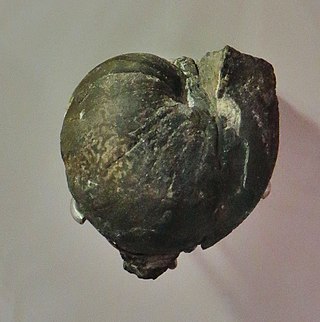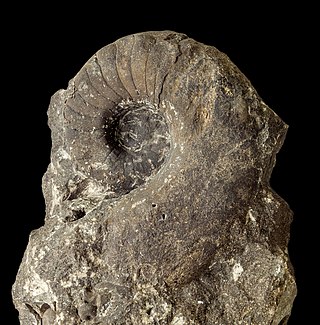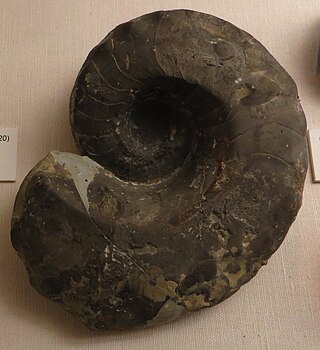The Tarphyceratidae are tightly coiled, evolute Tarphycerida with ventral siphuncles. The dorsum is characteristically impressed where the whorl presses against the venter of the previous. The Tarphyceratidae are derived from Bassleroceras or possibly from some member of the Estonioceratidae.
Permoceras, the sole member of the family Permoceratidae, is a genus of coiled nautiloids with a smooth, compressed involute shell, whorls higher than wide, earlier whorls hidden from view. The venter is rounded as are the ventral and umbilical shoulders, the flanks flattened. The siphuncle is ventrally subcentral. The suture, which is most characteristic, has a deep, narrow pointed ventral lobe and large, asymmetrical pointed lobes on either side.
Tithonoceras is a genus of nautiloid cephalopod from the Upper Jurassic found in the Crimea, belonging to the nautilacean family Paracenoceratidae.

The Trigonoceratoidea are a superfamily within the Nautilida that ranged from the Devonian to the Triassic, thought to have contained the source for the Nautilaceae in which Nautilus is found.
Syringonautilidae is a family of Nautiloidea from the middle to late Triassic. Syringonautilidae comprise the last of the Trigonoceratoidea and are the source for the Nautilaceae which continued the Nautiloidea through the Mesozoic and into the Cenozoic right down to the recent. Syringonautilidae is a strictly Triassic family, derived early in the Triassic from the Grypoceratidae.

Grypoceratidae is the longest-lived family of the Trigonoceratoidea, or of the near equivalent Centroceratina; members of the Nautilida from the Upper Paleozoic and Triassic.
The Centroceratidae is the ancestral family of the Trigonoceratoidea and of the equivalent Centroceratina; extinct shelled cephalopods belonging to the order Nautilida
The Naedyceras group comprises three similar and closely related openly coiled, gyroconic, genera within oncocerid family, Brevicoceratidae: Naedyceras, Gonionaedyceras, and Gyronaedyceras.
Aphelaeceras is an extinct genus from the nautilid family Trigonoceratidae which is part of the Trigonocerataceae, that lived during the Mississippian Period in the late Paleozoic.
Condraoceras is a genus of liroceratids from the Pennsylvanian of North America and Lower Permian of Europe with a compressed, involute, nautiliconic shell; subcircular whorl section; small umbilicus with a rounded shoulder; suture with shallow ventral and lateral lobes; and narrow subcentral siphuncle.

Peripetoceras is a genus in the Clydonautilacean family, Liroceratidae. It can be recognized by its smooth, involute shell with a deep small umbilicus with rounded shoulders and steep convex wall; whorl section with flattened venter, rounded ventral shoulders and convergent slightly convex flanks; suture with slight ventral and lateral lobes; and small siphuncle located dorsally of the center.

Metacoceras is a nautilitoid cephalopod from the Upper Carboniferous (Pennsylvanian) and Permian, the shell of which is moderately evolute with a subquadrate whorl section, bearing nodes on the ventral or umbilical shoulders or both, but otherwise smooth. The siphuncle is small, subcentral and orthochoanitic. The suture has shallow ventral and lateral lobes but no dorsal or annular lobe.
Enoploceras is a Tainoceratid genus, a nautiloid cephalopod in the order Nautilida, known from Triassic sediments in Europe, India, Timor, and the state of Idaho.
The Rhiphaeoceratidae are a small family of nautilids included in the superfamily Tainoceratoidea that comprises four very similar genera. These genera are characterized by a perforate umbilicus and little more than a single evolute coil. Whorl sections are oval, subquadrate, or subtrapezoidal. Sutures bend forward on the outer rim, forming wide shallow ventral saddles and dip strongly to the rear on the inner rim, forming deep dorsal lobes.
Pseudonautilidae is a family of Jurassic and Lower Cretaceous nautilid cephalopods belonging to the same superfamily as modern Nautilus, Nautilaceae, but forming a different branch from the family Nautilidae. Pseudonautilids, together with other nautilids, were contemporary with the ammonoids, which comprise an entirely different set of shelled cephalopod stocks more closely related to octopus and squid.
Nassauoceras is a tetragonoceratid nautiloid from the Middle Devonian of Europe, the shell of which is evolute with a wide, deep umbilicus, slight dorsal impression, low arched venter, rounded ventral shoulders, and flanks that converge dorsally so as to produce a subtrigonal whorl section. Nodes are present on the ventral shoulders. Sutures have shallow ventral and lateral lobes. The siphuncle is near the ventral margin.
Wellsoceras is a tetragonoceratid that starts off with an evolute shell in which whorls are in contact, but has a mature living chamber that diverges and becomes free. The whorl section is slightly wider than high and is faintly subquadrangular. Flanks are slightly convex and tend to converge very slightly toward the center. All shoulders are strongly rounded. The suture is straight ventrally or with a slight ventral lobe, well developed lateral lobes, and a broad, low dorsal saddle. The siphuncle is located half way between the center and the ventral margin.
Grypoceras is a coiled nautiloid cephalopod from the Triassic of western North America, southern Asia, and Europe that belongs to the nautilid family Grypoceratidae. Named by Alpheus Hyatt in 1883, the shell of Grypoceras is essentially involute with a subtriangular cross section, widest across the umbilical shoulders, with flanks fairing toward a narrow flattened venter. Sutures on flanks are with smooth, deep lobes and with shallow ventral lobes.

Germanonautilus is a cephalopod genus included in the nautilid family Tainoceratidae, found widespread in the Triassic of North America, Europe, Asia, and north Africa. The shell is a moderately involute nautilicone ; whorl section subquadrate to trapezoidal, widest across the umbilical shoulders, flanks flattened and ventrally convergent, venter flat and wide, dorsum narrowly and deeply impressed. The suture is with broad and deep lateral lobes and a shallow ventral lobe. The siphuncle is central and nummuloidal, composed of expanded segments that give a beaded appearance.

Domatoceras is a nautiloid genus and member of the Grypoceratidae from the Pennsylvanian and Permian with a wide spread distribution.



